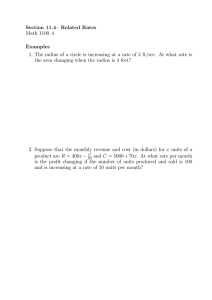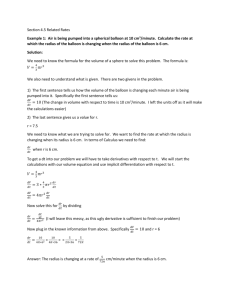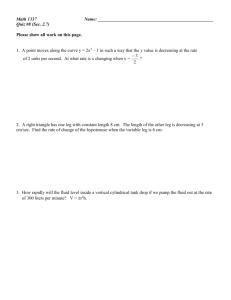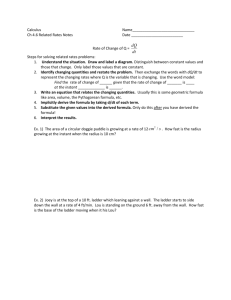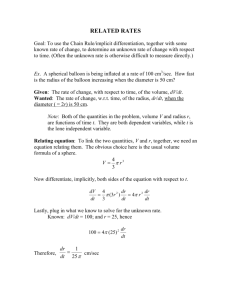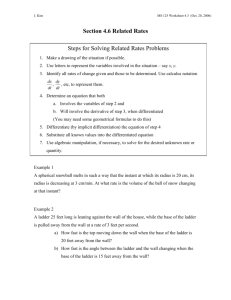Section 11.4, Related Rates
advertisement
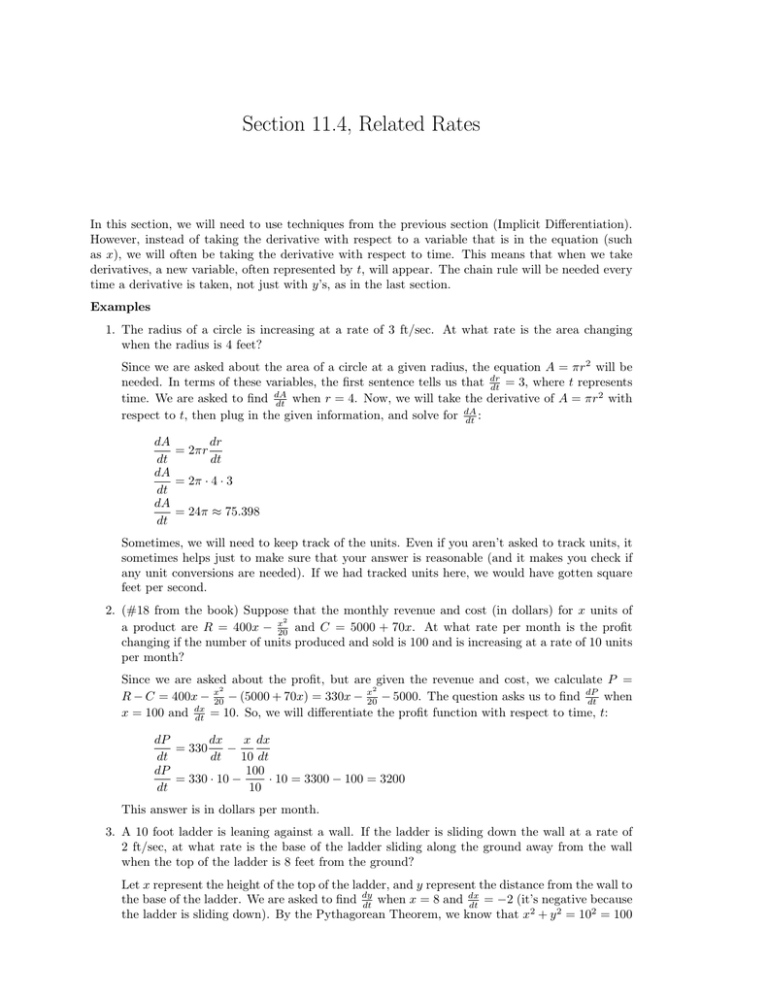
Section 11.4, Related Rates In this section, we will need to use techniques from the previous section (Implicit Differentiation). However, instead of taking the derivative with respect to a variable that is in the equation (such as x), we will often be taking the derivative with respect to time. This means that when we take derivatives, a new variable, often represented by t, will appear. The chain rule will be needed every time a derivative is taken, not just with y’s, as in the last section. Examples 1. The radius of a circle is increasing at a rate of 3 ft/sec. At what rate is the area changing when the radius is 4 feet? Since we are asked about the area of a circle at a given radius, the equation A = πr2 will be needed. In terms of these variables, the first sentence tells us that dr dt = 3, where t represents dA time. We are asked to find dt when r = 4. Now, we will take the derivative of A = πr2 with respect to t, then plug in the given information, and solve for dA dt : dA dr = 2πr dt dt dA = 2π · 4 · 3 dt dA = 24π ≈ 75.398 dt Sometimes, we will need to keep track of the units. Even if you aren’t asked to track units, it sometimes helps just to make sure that your answer is reasonable (and it makes you check if any unit conversions are needed). If we had tracked units here, we would have gotten square feet per second. 2. (#18 from the book) Suppose that the monthly revenue and cost (in dollars) for x units of 2 a product are R = 400x − x20 and C = 5000 + 70x. At what rate per month is the profit changing if the number of units produced and sold is 100 and is increasing at a rate of 10 units per month? Since we are asked about the profit, but are given the revenue and cost, we calculate P = 2 2 R − C = 400x − x20 − (5000 + 70x) = 330x − x20 − 5000. The question asks us to find dP dt when x = 100 and dx = 10. So, we will differentiate the profit function with respect to time, t: dt dP dx x dx = 330 − dt dt 10 dt dP 100 = 330 · 10 − · 10 = 3300 − 100 = 3200 dt 10 This answer is in dollars per month. 3. A 10 foot ladder is leaning against a wall. If the ladder is sliding down the wall at a rate of 2 ft/sec, at what rate is the base of the ladder sliding along the ground away from the wall when the top of the ladder is 8 feet from the ground? Let x represent the height of the top of the ladder, and y represent the distance from the wall to dx the base of the ladder. We are asked to find dy dt when x = 8 and dt = −2 (it’s negative because the ladder is sliding down). By the Pythagorean Theorem, we know that x2 + y 2 = 102 = 100 (This also gives us that y = 6 when x = 8). Then: dx dy + 2y =0 dt dt dy 2 · 8 · (−2) + 2 · 6 =0 dt dy 32 8 = = ft/sec dt 12 3 2x 4. The volume of a spherical balloon is changing at a rate of 3 cubic inches per second. At what rate is the radius changing when the radius is 4 inches? Recall the formula for the volume of a sphere: V = 34 πr3 . We want to find and r = 4. dV dr = 4πr2 dt dt dr 3 = 4π · 42 dt dr 3 = ≈ 0.0149 in/sec dt 64π dr dt when dV dt =3
